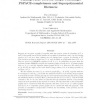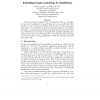202 search results - page 15 / 41 » On the Queue Number of Planar Graphs |
COCO
2009
Springer
15 years 6 months ago
2009
Springer
Graph Isomorphism is the prime example of a computational problem with a wide difference between the best known lower and upper bounds on its complexity. There is a significant ...
82
Voted
MFCS
2007
Springer
15 years 5 months ago
2007
Springer
Suppose we are given a graph G together with two proper vertex k-colourings of G, α and β. How easily can we decide whether it is possible to transform α into β by recolouring...
ARSCOM
2002
14 years 11 months ago
2002
Given a non-planar graph G with a subdivision of K5 as a subgraph, we can either transform the K5-subdivision into a K3,3-subdivision if it is possible, or else we obtain a partit...
CORR
2008
Springer
14 years 11 months ago
2008
Springer
Reachability and distance computation are known to be NL-complete in general graphs, but within UL co-UL if the graphs are planar. However, finding longest paths is known to be N...
129
click to vote
FOCS
2004
IEEE
15 years 3 months ago
2004
IEEE
We study the maximum edge-disjoint paths problem in undirected planar graphs: given a graph G and node pairs (demands) s1t1, s2t2, . . ., sktk, the goal is to maximize the number ...


